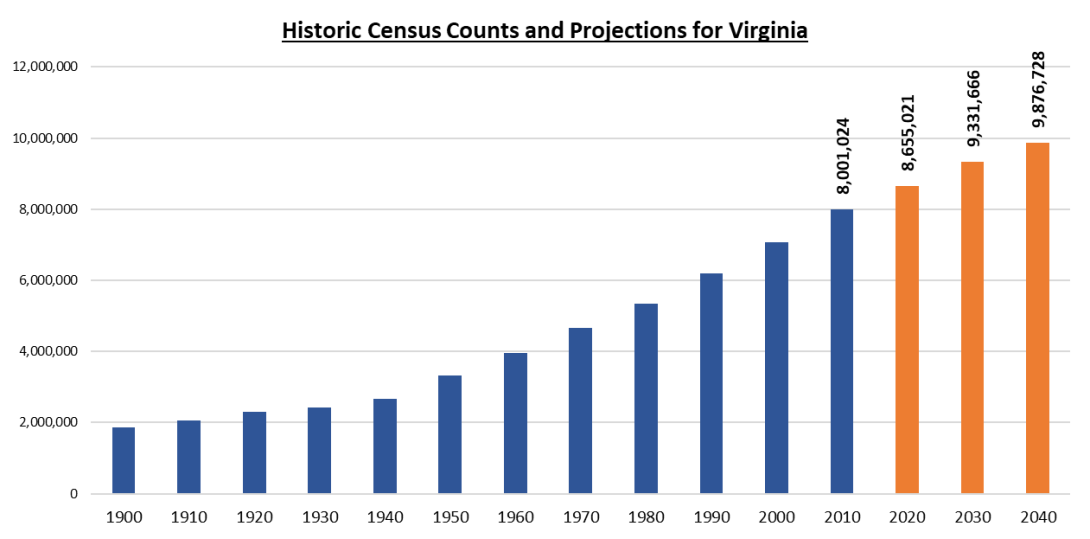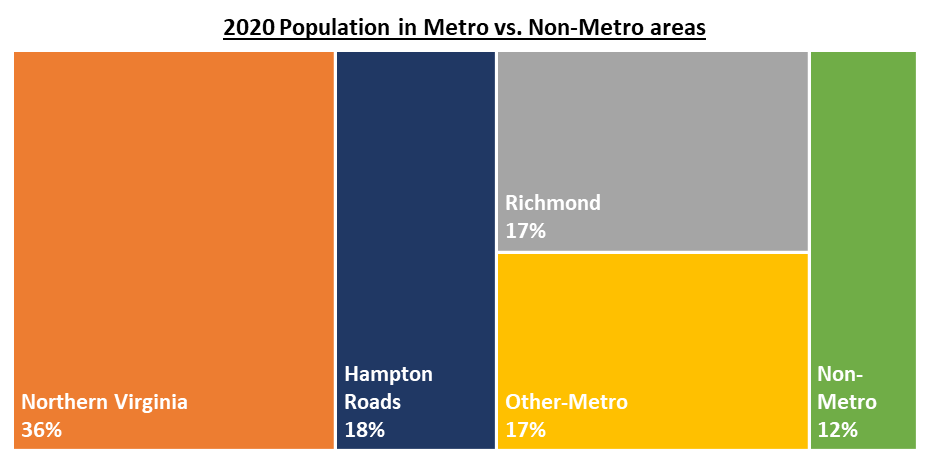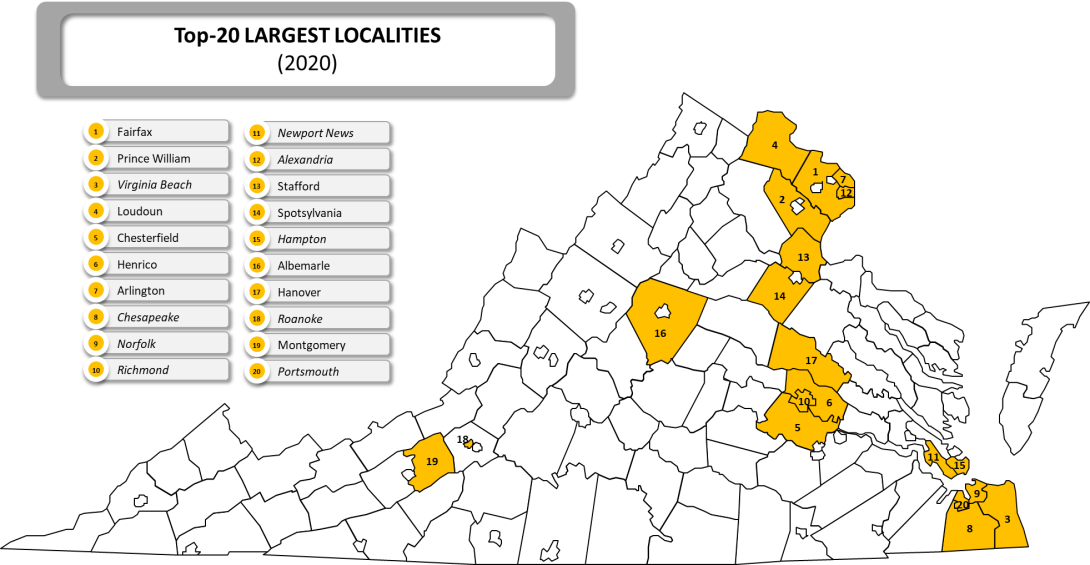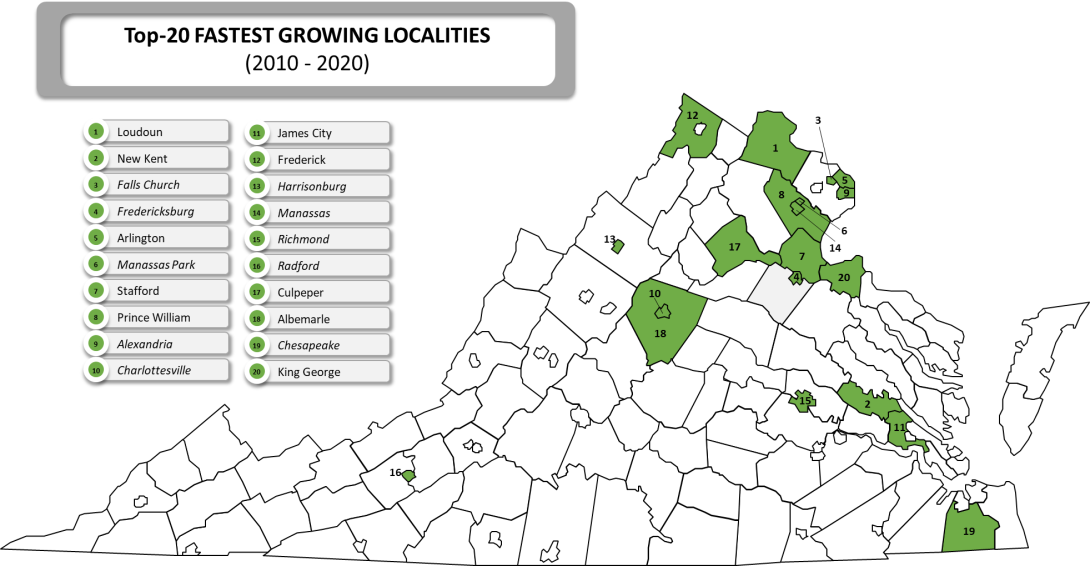Population Projections show that Virginia is aging and growing more slowly

Having a crystal ball that could foresee the future would be ideal, but in reality we can only rely on our ability to project Virginia’s population based on past trends. Population projections provide a lens to look into the future to anticipate what the decades ahead may hold. While projections are inherently uncertain, as the future is largely unknown, accuracy at larger geographic levels—and for the near future—can be highly valuable and useful. They provide us with a baseline for planning, and guide the needs and priorities for decision-making across the Commonwealth.
The Weldon Cooper Center at the University of Virginia recently released the updated 2019 population projections for all counties, cities, and large towns across Virginia. These updated projections show that while Virginia continues to grow in population size, the pace of growth may be a little slower than what was earlier projected, with a 2020 population of 8.65 million. The 13% statewide growth rate of the last decade (2000-2010) has decelerated to 8% for the current decade and is anticipated to hold steady through 2020-2030 assuming that current trends will continue, specifically lower births, higher deaths (result of aging), and fewer people moving into the state.

This growth, however, is not uniform across the entire Commonwealth, with a significant rural-urban divide becoming more evident as time progresses. Northern Virginia continues to dominate, with over 3 million people in 2020, while Richmond and Hampton Roads each is expected to have over 1.5 million residents. In contrast, rural communities are witnessing a population decline, both in the present as well as projected over the future decades up to 2040. This pattern is reflected in the regional population shares across Virginia (treemap below), with 70% of the state’s population residing in the three largest metropolitan areas and only 12% of Virginians living in non-metro areas.

The projections for the 133 cities and counties demonstrates the evolution of Virginia’s demographic landscape. The rapid population growth of the earlier decades has slowed down considerably; more than 60 cities and counties are projected to see a decline in this decade (2010-2020), with Buchanan and Dickenson expecting their population to fall by more than 10%. On the flipside, only 26 localities are projected to grow by more than 10% in the 2010-2020 decade. The maps below show the top 20 localities with the highest population size in 2020 (yellow) and the top 20 localities with the highest percentage of population growth over 2010-2020 (green), further highlighting the geographic concentration in urban areas. Eight cities and counties appear on both lists, which means they have large population sizes and are also the fastest growing counties across Virginia (namely, Albemarle, Alexandria, Arlington, Chesapeake, Loudoun, Prince William, Richmond city, and Stafford).


In addition to geographic variation in population change, the shift in age composition of the Commonwealth is also notable. Virginia’s age distribution (as seen in figure below) demonstrates the shrinking share of the under-19-year-olds and the cohorts aged 20-64 over the successive decades. But the share of older Virginians—ages 65 and over—is expected to increase from 12% in 2010 to 18% in 2030, fueled by an aging baby-boomer generation and declining birth rates. The economic impact of these demographic trends is partially reflected in the dependency ratio (ratio of elderly to working age population) which is expected to rise from 20% in 2010 to 26% in 2020 and 32% in 2030.

By 2020, more than 15% of Virginians are expected to be over the age of 65, with a greater number of 65+ residents living in rural areas. For example, in Lancaster, Northumberland, Middlesex, Highland, and James City it is projected that more than 30% of their residents will be 65 years or older by the end of this decade – which is twice the state average.
The Cooper Center projections for Virginia are the result of rigorous research and development, which includes exploring different methodologies and testing multiple models. Our current approach uses a combination of exponential and linear extrapolation, in conjunction with the Hamilton-Perry method, to derive projections for the total population as well as by age and gender. These projections provide a probable future for the Commonwealth’s population, given past observations and current trends. With the 2020 Census fast approaching next year, we as researchers and data enthusiasts are looking forward to the once-in-a-decade opportunity to evaluate the accuracy of the 2020 projections, using the 2020 Census counts which will be released in 2021.


